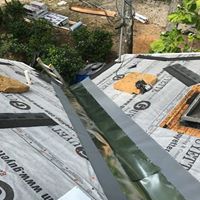Roof valleys, if not installed correctly are one of the most leak-prone areas on the roof. Because roof valleys function as a drain on the roof, they receive a disproportionate volume of water every time it rains. Leaking roof valleys are some of the most common roof repairs requested.
Just like in nature, a valley on a roof is designed to collect water; if that water doesn’t shed off the roof fast enough or gets under the roofing material, roof leaks will soon develop. Roof leaks in valleys often turn into unsightly repairs. Let’s look at leaking roof valleys and the best way to fix them.
Best Practices for Repairing Leaking Roof Valleys
When a valley begins to leak it’s very difficult to surgically address the leak. The best way to find and stop the roof leak is to start over and roof the valley the right way. That’s what we’ve done here in Montgomery’s Old Cloverdale neighborhood. We removed all old roofing material down to the original wood deck. Then installed a layer of GAF Storm Guard underlayment and 20′ valley flashing. Instead of going back with an open metal valley, we installed a closed metal valley system. A properly installed closed valley system prevents future leaks with wind-driven rains. Then, we installed architectural shingles to match the existing roofing material.
When driving through neighborhoods with lots of shingle roofs, the ascetics of each roof system is different. Apart from shingle color and style shingle, one of the main differences from roof to roof is the method the valleys are built. There are two predominant ways valleys are built in a shingle system. The roofer can either install a closed valley or an open valley system.
Roof valleys should have some type of lining or underlayment beneath the shingles that is not visible. We like to put a self-adhering membrane directly onto the wood deck, then a piece of 20-inch wide metal down the entire valley. The metal coupled with the self-adhering lining is a bit overkill, but it’s how we like to do it, especially when installing our Ultimate Roof System.
The next step in constructing a valley is where the appearance begins to change. A roofer can install an open valley by laying shingles on either side of the valley, then cutting each side a few inches short of the center, thus exposing the metal. If done correctly, this method works. In fact, for certain asphalt shingles (extremely thick, 50-year + shingles), this is the only method to correctly install a roof valley. However, most standard, residential shingles don’t meet the thickness requirement for an open valley. And this is where a lot of roofers go wrong.
For 90% of asphalt shingle roofs, a closed valley system is the best method for installing a roof valley. The preliminary components of a closed valley are the same for an open valley. Although many roofers skip this step, some type of valley lining is necessary for the long-term success of a roof valley. We install 20-inch wide valley flashing on all of our roofs. On our Ultimate Roof System, we install self-adhering Ice and Water underlayment under the valley metal. When then take the lower-pitched, or smaller side (the panel that receives the least amount of water), and use that as our base. We lay an entire shingle across the valley. It’s important that the nails used to fasten the shingles stay within 10 inches of the center of the valley. On the other panel, we lay a shingle on top of the base shingle, only nailing the side of the shingle furthest from the valley. Then we snap a line, cutting the shingles from the second panel (the non-base side) down the middle of the valley.
The closed valley system, when done correctly and with the proper underlining, performs better with wind-driven rain.
Roofers have to be trained the right way to roof a valley. There are several ways to roof a valley that could be considered “correct”, but based on our experience, a closed valley system, with standard GAF Timberline HD architectural shingle, does better in preventing leaks from wind-driven rains.
Guyette Roofing is Here to Help
If you have a leaking roof valley and need it repaired, Guyette roofing is here to help. We proudly serve the Montgomery, Birmingham, and Mobile, Alabama areas. Contact us to receive a free estimate and let’s get your roof repaired the right way!

